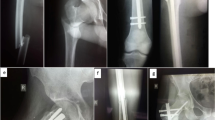Abstract
Each year nearly 5 million people worldwide die from injuries, approximately the number of deaths caused by HIV/AIDS, malaria, and tuberculosis combined. Ninety percent of these injuries occur in developing countries and that number is growing. Road traffic accidents account for 1.2 million of these 5 million deaths. For each death from trauma, three to eight more are permanently disabled. Orthopaedic surgeons should consider the victims of this epidemic by using their ability and capacity to treat these injuries. SIGN (Surgical Implant Generation Network, Richland, WA, USA) builds local surgical capability in developing countries by providing training and equipment to surgeons for use in treating the poor. It assists in treating long-bone fractures by using an intramedullary nail interlocking screw system. C-arm imaging, unavailable in many of these hospitals, is not necessary to accomplish interlocking. Surgery is performed primarily by local surgeons who record their cases on the SIGN surgical database. Discussion of these reports provides a means of communication and education among surgeons. This database demonstrates the capability of these surgeons. It also demonstrates that the SIGN intramedullary nail is safe for use in the developing world as it has been successful in treating 36,000 trauma patients.


Similar content being viewed by others
References
Beveridge M, Howard A. The burden of orthopaedic disease in developing countries. J Bone Joint Surg Am. 2004;86:1819–1822.
Ghaffar A, Hyder AA, Bishai D, Morrow RH. Interventions for control of road traffic injuries: review of effectiveness literature. J Pak Med Assoc. 2002;52:69–73.
Krug EG, Sharma GK, Lozano R. The global burden of injuries. Am J Public Health. 2000;90:523–526.
Mathers CD, Lopez AD, Murray CJ. The burden of disease and mortality by condition: data, methods, and results for 2001. In: Lopez AD, Mathers CD, Ezzati M, Jamison DT, Murray CJ, eds. Global Burden of Disease and Risk Factors. New York, NY: Oxford University Press; 2006:45–93.
Mock CN. Injuries in the developing world. West J Med. 2001;175:372–374.
Murray CJ, Lopez AD. The global burden of disease: a comprehensive assessment of mortality and disability from diseases, injuries and risk factors in 1990 and projected to 2020 (Global burden of disease and injury series; vol. 1). Boston, MA: Harvard School of Public Health; 1996.
Peden M. Global collaboration on road traffic injury prevention. Inj Contr Saf Promot. 2005;12:85–91.
Peden MM, McGee K, Krug E. Injury: a leading cause of the global burden of disease, 2000. Geneva: WHO; 2002.
Acknowledgment
I thank the many orthopaedic surgeons around the world and others too numerous to mention who contribute to the expansion of SIGN.
Author information
Authors and Affiliations
Corresponding author
Additional information
The author certifies that he founded and is president of SIGN, a non-profit entity, but does not receive payments or benefits from that entity.
Appendix
Appendix
About this article
Cite this article
Zirkle, L.G. Injuries in Developing Countries—How Can We Help?: The Role of Orthopaedic Surgeons. Clin Orthop Relat Res 466, 2443–2450 (2008). https://doi.org/10.1007/s11999-008-0387-0
Received:
Accepted:
Published:
Issue Date:
DOI: https://doi.org/10.1007/s11999-008-0387-0




